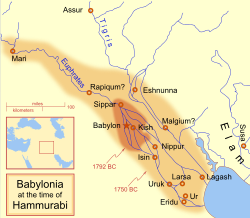Babylonia
Babylonia was a city state in Mesopotamia in the 2nd millennium BC, over 3000 years ago. Babylonia's capital city was Babylon, which meant The Gate of the Gods. They built an empire out of the lands of the former Akkadian Empire.
Geography
Mesopotamia is the region of the two rivers, Euphrates and Tigris. At that time the region also included the city states of Assyria to the north, and Elam to the south-east. It is part of the Fertile Crescent in the Middle East. It was there people first lived together in a civilization, with farming, cities and writing.
Old Babylonia

The Babylonians had a written language that they used for trade and communication. They got it from the Sumerians, who invented it. The Babylonians used the same cuneiform system of pressing triangular shapes into soft clay. They wrote in two different languages: Sumerian for religious purposes and Akkadian language for official purposes.[2]
Laws
Hammurabi was a king of Babylon who fought wars. He made Babylonia into an empire by putting Assyria under a vassal (puppet) king. He made the earliest written set of laws, the Code of Hammurabi. It has 280 judgments. It is still placed on display today in the Louvre of Paris, France. The earlier Sumerian punishments had not been harsh, but Babylonian law was quite severe. The death penalty was given for theft, murder and other crimes.
Buildings
The houses in Babylon had open roofs, so that on hot nights, the family could sleep there. The living rooms, dining rooms, and the kitchens were, of course, downstairs. Lamps burned with olive oil, and every house had a chapel for burial and worship ceremonies.
Since Mesopotamia had only clay for use in building, the strong wooden supports for the houses were imported from Lebanon. Eventually, residents began baking their bricks and improved the strength of their houses.
Sack of Babylon
Later, Babylon was sacked by the Hittite king Musilis I,[3] which led to the so-called Dark Ages of the Bronze Age, where there is little evidence in writing.
Dating
The date of the sacking of Babylon is debated by archaeologists, who have proposed no fewer than four chronologies. Possible dates for the sack of Babylon are:
- ultra-short chronology: 1499 BC
- short chronology: 1531 BC
- middle chronology: 1595 BC
- long chronology: 1651 BC
The difficulty is to line up the Mesopotamian dates with the ancient Egyptian dates.
Later dynasties

After the Hittites' destruction, Babylon was ruled by Kassites for 576 years. Next it was ruled by Elam, and then regained its independence for about three centuries. They were then conquered by the Neo-Assyrians. A century later they again became free, to form the Neo-Babylonian or Chaldean Empire. This constant conquest and re-conquest is partly due to geography. There are no natural boundaries except the rivers, and it is easy to get at the cities from north or south. The king Nebuchadnezzar II reigned for 43 years. He conquered Phoenicia in 585 BC.[4]
Cyrus the Great
The Babylonian empire was finally brought to an end by Cyrus the Great of Persia. It was in 549 BC that Cyrus put an end to the empire of the Medes. Three years later Cyrus had become king of the Achaemenid Empire (Persia), and was engaged in a campaign in northern Mesopotamia. In 539 BC Cyrus invaded Babylonia. A battle was fought at Opis in the month of June, where the Babylonians were defeated; and immediately afterwards Sippara surrendered to the invader. Two days after the capture of Sippara, "the soldiers of Cyrus entered Babylon without fighting". Cyrus did not arrive until the 3rd of Marchesvan (October), Gobryas having acted for him in his absence. Gobryas was now made governor of the province of Babylon.
Cyrus now claimed to be the legitimate successor of the ancient Babylonian kings and the avenger of their god Bel-Marduk. The invasion of Babylonia by Cyrus was doubtless helped by the presence of foreign forced exiles like the Jews, who had been planted in the midst of the country. One of the first acts of Cyrus was to allow these exiles to return to their own homes, carrying with them the images of their god and their sacred vessels. The permission to do so was embodied in a proclamation, whereby the conqueror endeavored to justify his claim to the Babylonian throne. The feeling was still strong that none had a right to rule over Western Asia until he had been consecrated to the office by Bel and his priests; and accordingly, Cyrus henceforth assumed the imperial title of "King of Babylon."
Food
Like the Sumerians, the Babylonians ate vegetables, fruits, meat and fish. They also ate bread and enjoyed toasting and eating the pesky but crunchy locusts which destroyed their precious crops.
Art
The Babylonians loved art. Beautiful vessels ornamented with sparkling gold were buried with the kings. In those days books dealt with floods which were thought to be caused by sin, or about the journey of Abraham.
Science
Science saw substantial improvement as well. The Babylonians invented the first calendar, the 60-minute hour and advanced multiplication table.
Life
Life was rich, full[clarification needed] and usually peaceful. People rarely thought about war or how to protect the city. As a result, Babylon was conquered in 730 BC by the Assyrians and Kassites. This great civilization then ended.
Babylonia Media
Babylonian prisoners under the surveillance of an Assyrian guard, reign of Ashurbanipal 668–630 BC, Nineveh, British Museum ME 124788
Related pages
References
- ↑ Roux, Georges (27 August 1992), "The Time of Confusion", Ancient Iraq, Penguin Books, p. 266, ISBN 9780141938257
- ↑ Deutscher, Guy (2007). Syntactic change in Akkadian: The evolution of sentential complementation. Oxford University Press. pp. 20–21. ISBN 9780199532223.
- ↑ Sacking a city: conquering it with much destruction.
- ↑ "World Wide School". History of Phoenicia — Part IV. Retrieved 2007-01-09.







